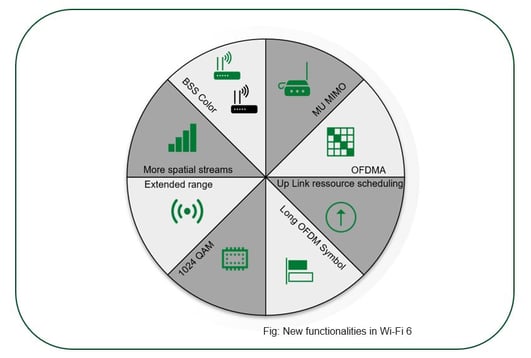Wi-Fi 6 boasts of additional benefits and improvements compared to its predecessor, Wi-Fi 5. Here we look into some of the key features offered in Wi-Fi 6 and how they compare to Wi-Fi 5.
Known under its technical name as 802.11ax, Wi-Fi 6 is the latest addition to the Wi-Fi family, and ISPs across Europe are rolling it out as we speak. Focused on increasing the overall performance, Wi-Fi 6 is ideal for responding to the current changes in digital customer behavior. It employs technology that enables end-users to achieve a superior Wi-Fi experience with higher speeds and lower latency, even at a distance.
– Today’s end-users expect a wireless connection that works seamlessly in every corner of their home – even in the garden. Even when they are streaming content in full HD or 4K furthest away from the router, they are looking for high performance, wherever and whenever. End-users expect a minimum range of 50-100 Mbit/s in every corner of their home, says Jens Bundgaard, Technical Program Manager at Icotera.

“1000 Mbit/s connections are now a standard off-the-shelf product. Therefore, ISPs need to differentiate their offerings by providing a superior Wi-Fi experience. Wi-Fi 6 can be the solution that allows the ISP to stay ahead of the game.”
–Jens Bundgaard, Technical Program Manager, Icotera
Increased performance, stability, and quality
Although Wi-Fi 6 offers a mere 25 percent more bandwidth compared to Wi-Fi 5, it stands out by providing several overall improvements in three areas: Performance, stability, and quality. Notably, issues with high latency seen in past Wi-Fi technologies, including Wi-Fi 5, have been improved.
– A key takeaway from the Coronavirus pandemic is how important a low latency Wi-Fi connection is for critical business meetings. Users want to uphold the same level of professionalism as if they were meeting physically. Therefore, latency issues, screen freeze, poor audio quality, and signal dropouts are no longer acceptable. Upgrading to Wi-Fi 6 helps users solve these common connection issues, as it offers up to 75 percent improved latency compared to Wi-Fi 5, explains Bundgaard.
It is the new technological feature in Wi-Fi 6 called “Orthogonal Frequency-Division Multiple Access”, also abbreviated as OFDMA, that significantly reduces latency. OFDMA is designed explicitly for dense environments with a goal to prevent the bottleneck situations that result in increased lag, so that the user’s connection remains uninterrupted and stable.

The more antennas, the better the Wi-Fi experience
The Wi-Fi 5 standard is designed with only four antennas for each band, whereas a Wi-Fi 6 router makes it possible to use up to eight antennas. The number of antennas determines the quality of the Wi-Fi connection, and by doubling the number of antennas, ISPs can offer a Wi-Fi experience with stable coverage for their customers.
– By choosing to provide your customers with a router with eight antennas (8x8), you automatically reduce the need for Wi-Fi repeaters and extenders remarkably. The improved Wi-Fi signal across the entire home also helps reduce the customer’s need for support, says Bundgaard.
An average household has several users and smart devices connected at any given time. Therefore, Multi-User, Multiple Input, Multiple Output technology, better known as MU-MIMO, is employed to enable the Wi-Fi router to connect with multiple devices at a high connection speed. While this is not a new technology compared to Wi-Fi 5, MU-MIMO requires more than four antennas for full efficiency. This means that Wi-Fi 5 is incapable of utilizing MU-MIMO to its full capacity in real-life scenarios.
The unique combination of the eight antennas, OFDMA, and MU-MIMO technologies enables Wi-Fi 6 to improve coverage and performance in any environment – from traditional homes to densely populated building blocks. Additionally, the communication between the router and individual devices is more efficient than with a Wi-Fi 5 router.
Bundgaard also comments on the growing trend in Europe where ISPs are rolling out Wi-Fi 6 solutions to stay commercially competitive, as he ends:
– 1000 Mbit/s connections are now a standard off-the-shelf product. Therefore, ISPs need to differentiate their offerings by providing a superior Wi-Fi experience, and in doing so, they will stand out from their competitors. Wi-Fi 6 can be the solution that allows the ISP to stay ahead of the game, but it must be utilized properly by offering the highest possible antenna configuration for best performance - at least 5x5, and preferably 8x8.
-----------------------------------------------------------------
![]()
Interested in how your ISP business can benefit from using a Wi-Fi 6 solution, feel free to contact our Technical Program Manager, Jens Bundgaard, jbu@icotera.com
-----------------------------------------------------------------
WANT TO KNOW MORE.....
..... about how your ISP business can stay ahead of the competition? In this e-book, we look into how choosing the right business strategy and using customer data to deliver a proactive customer experience are two ways that will help you build a strong business case. And much more...
Download E-book: The competitive ISP here

